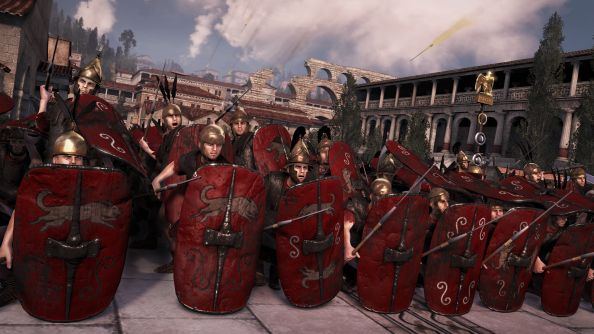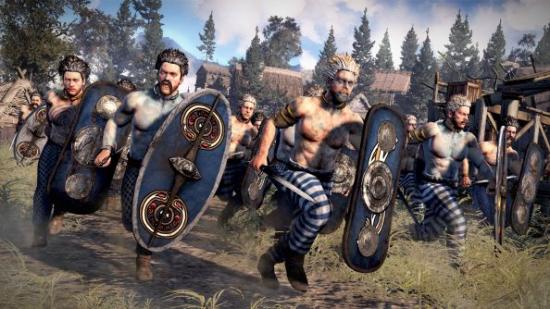Creative Assembly’s Total War: Rome 2 is ticking along nicely. I recently had the chance to sit with the some of the game’s lead developers about the campaign and watch one of the game’s historical battles: Teutoburg Forest. We’ll have more on the game shortly, but here’s an overview of what we learned.
The gauntlet the Roman soldiers ran through Tuetoburg forest lasted for three days. As they raced to their winter encampments, Rome’s best soldiers were harassed and ambushed from every side. By the end, not a single legion remained. Teutoburg was a disaster for the empire.
The gauntlet Al Bickham, Creative Assembly’s Studio Communications Manager runs through Tuetoburg forest lasts for about twenty minutes. As he races to the objective marker, Rome’s best soldiers are harassed and ambushed from every side. By the end, a few scant units, aided by the noble sacrifice of legionaries who block the final wave of screaming Berserkers, make it safely out of the woods.
Total War is an alternate history. But as I watch Al scamper through the woods, I realise something terribly meta. Al is playing through a new take on an old problem: Teutoburg forest was one of the historical battles from the original Rome: Total War. The trouble is, it wasn’t very good – it was just too small, too limited. All it did was show the limits of what the original game could do. Now, inside Rome 2, I’m watching Al rewrite Total War history, while rewriting history.
In Rome 2’s take, players face the same problems: not enough men, and what men there are are outflanked at every turn. The scale of the battle is truly something: Tuetoburg Forest is filled with endless angry Germans – charging out of the woods, down the valley, and across the streams and copses that run through it. Many men die. It is glorious.

Total War: Rome 2 is a very good looking game. The 20 minute hands off demo I saw was frequently astonishing. The number of troops on screen was a significant increase from what I’ve experienced in Total War previously: but far better was the improved level of detail from Shogun 2. Al explained that now, the units have mass, and when they collide, the impact of that mass is reflected in the animations. When two legions crash into each-other – you can see and feel the crunch.
It’s even more pronounced when cavalry charges. In previous games, the riders would smash into a line but then come to a halt in a fixed position behind. When Al charged a group of archers that were raining fire arrows on his infantry, a new dynamic appeared: the horse didn’t stop once they’d broken the line – they wheeled around as a unit and reformed for a second charge. It was beautiful to behold.
There’s a new fluidity to the scenes, too. As a testudo charged a line the final line of German infantry, I waited for the old Rome pause: where veteran infantry would come to a halt and then throw their short spears into the Barbarian wall. That never came. Instead, the testudo continued moving, throwing their spears on the run, before pulling their shields back down and marching into the fray.

Lastly: the mini-map has been expunged from the game, replaced by a full-screen tactical map. We knew that from the initial Rome 2 reveal. Now, you can order and move your troops from that tactical map – giving you a birds eye, semi-illustrated look at the shape of your line. I think it’s a great touch.
So: we know Rome 2’s battles will probably be good. But what of the campaign?
During my time at CA, I heard a plenty about how the mechanics of the campaign map is changing to reflect and improve on what occurred in Shogun 2. But the campaign map just isn’t ready – it’s still in the very early stages. However, the developers were bandying around plenty of changes – I’ve tried to summarise them all below as bullet points.
- Regions are now grouped into provinces. Each has a single administration centre, into which the surrounding regions report. The goal is to reduce some of the area micromanagement that occurs in vast empires.
- Another goal from this new system is to avoid the relentless siege battles of Shogun 2. It’s believed that players will attempt to take the smaller regions first, and tempt the opposing armies out of their castles to fight on the field.
- Armies are ‘raised’ on the field, and recruitment occurs at the general of that army. They’re not grown as single units in towns. Again, the idea is to reduce some of the micromanagement (‘Caesar doesn’t give a fuck about an individual’ says Al) but also to create a stronger personality to your armies. Hence…
- Armies have their own skill trees, with improvements earned through battle.
- Armies have at least three possible stances that you can place them in during a turn. I’m not certain the mechanics of how they will play out in the campaign are quite fixed, but it was hinted that switching stances would take a turn. They are… normal, ambush (hidden from the enemy’s sight),forced march (quicker to move, but if caught on the hop, they’ll suffer diminished combat effectiveness), defensive (given a fort or pallisade to defend from)
- When moving armies over water, you no longer need to load them into a separate navy. They will automatically enter transport ships. You will still require a navy to protect them.
- The factions in the game are more clearly defined with starting bonuses and traits. There are ‘flavours’ of faction which should help organise your thoughts. For instance, Barbarians like the Gauls will have similar traits. In the barbarian’s case, that includes a +2 happiness in every settlement for every faction they’re fighting with.
- Naval battles are now fought over naval ‘regions’, rather than having a completely fluid ocean. “This was decided because having a completely organic map wouldn’t be something that would work that well,” says lead Battle Designer Jamie Ferguson, “you needed to be able to actually think that “this is the area I’m trying to defend”. It’s using things we have already got in the game but at the same time bringing back things from the past.
- During battles, units will have true line of sight, the distance of which they can detect changes according to their role. Armies can therefore be hidden behind trees or in valleys, and will require the use of scouts to be spotted.
- Armies that catch another in ambush will be able to place deployables like burning boulders, and place their forces all over the map. The army caught in the ambush won’t be placed at the other end of the battle map – they’ll arrive in a marching formation.
- Each nation will have their own UI decorators.
What I took from these mechanical changes was a sense of progress. Total War tends to improve each game; but more interestingly, sometimes the mistakes of previous games are undone. Everyone I spoke to was especially keen to avoid the siege grind that occurs in Shogun 2 – the details of how regions and provinces work was specifically cited as a response to that problem.
But more importantly, perhaps, was the sense that Rome 2 was set to be a better engine for telling grander stories.

Excuse the quick diversion into game theory. Depth in games can come from verbs: i.e. the number of actions you can take in a scenario to influence it. Total War has had the same verbs for a long time. Attack, tax, siege, retreat, build, attack. That loop is fundamentally fun: I will never tire of painting Europe my colour.
But if Rome 2 is to be a better game than Rome 1, properly reflecting the drama and intrigue of the period, it needs more verbs, and more space for them to play in.
The story behind Tuetoburg forest is incredible. It’s the story of a general, Armenius, taken from his German parents and raised a Roman, who returned to his country as a cavalry commander. When he saw the treatment of his people by the then governer, Varrus, he hatched a plan – to collaborate with and unify the local tribes. They would harass the Roman armies, keeping them in the field for weeks beyond when they were meant to leave for their Winter camps. That forced them into taking a shortcut, Tuetoburg forest, where Armenius sprung his trap.
I don’t think that level of intrigue has been possible in a Total War game. The combination of AI and game design just hasn’t existed. The end-game for Total War is for Creative Assembly’s combination of art and technology to build a story as cunning and exciting around what players do. My hope is that by letting players do more: by giving them the option of forced marches, and ambushes, and prefectures and naval regions and everything else, Total War tells better stories.
